- EraMedieval/Islamic
- Project DirectorDr. Nicholas Warner
- LocationCairo
- AffiliationARCE
- Project SponsorARCE
- Project Dates:2022-2024
Written by: Sally El Sabbahy and Nicholas Warner
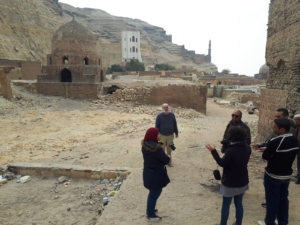
Trainees visit the site in March 2022 as part of an advanced training on photogrammetric documentation organized by ARCE. PC: Sally El Sabbahy
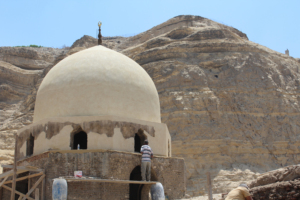
The dome during external repair works in June 2022. PC: Sally El Sabbahy
Nestled in the eastern hillside of the Mokattam escarpment, about 15 minutes’ drive from the Cairo Citadel, is the Shrine of Ikhwat Yusuf (‘Brothers of Joseph’). This rare survival from the Fatimid period was constructed at some point in the early 12th century in the southernmost extension of Cairo’s historic City of the Dead. The shrine is comprised of a domed mausoleum that is approached through two adjacent prayer rooms. The mausoleum still retains its original ‘triple’ mihrab (prayer niche) framed by carved stucco decoration with geometric motifs and inscriptions in an elaborate floriated Kufic – a particularly popular form during the Fatimid Caliphate (909-1171). Since 1991 the monument has seen several interventions aimed at consolidating at risk architectural elements, such as its dome, and clearing debris and rubble from its interior. Despite these efforts by the Supreme Council of Antiquities (SCA), the condition of the shrine continued to deteriorate in its physical integrity and appearance. This was manifest in the loss of external plaster and window grilles, major structural cracks, and the collapse of a limestone roof vault.
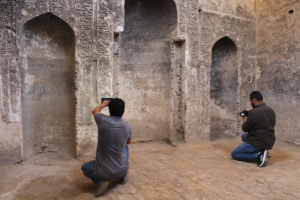
Osama Dawod of Factum Arte and Mohab Abd ElMegid of the Ministry of Tourism and Antiquities do follow-up photogrammetry on the mihrab in July 2022. PC: Sally El Sabbahy
After applying to the SCA for permission to conserve the monument in 2021, ARCE was granted approval to carry out work beginning in 2022 with an anticipated completion of the project in mid-2024. The first year of work in 2022 consisted of interventions that focused on the clearance of accumulated debris from in and around the Shrine, physical conservation of masonry, digital documentation of the entire monument and its stucco mihrab by CPT Studio and Factum Arte, respectively, and an advanced training course in photogrammetry and 3D modelling for four inspectors from the Ministry of Tourism and Antiquities (MoTA) by Dina Bakhoum and Dr. David Anderson of the University of Wisconsin-La Crosse. Notably, two of the trainees went on to provide invaluable support towards ARCE’s documentation efforts at the Shrine; with Suzan Fathy assisting the project conservator Bianca Madden in the documentation of historic graffiti left by religious visitors inside the monument, and Mohab Abd ElMegid assisting Factum Arte in carrying out follow-up photogrammetric documentation of the mihrab.
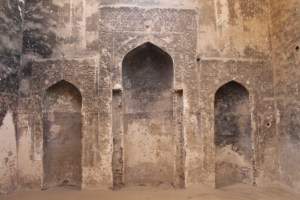
The carved stucco triple mihrab from the Shrine’s central prayer hall, a rare Fatimid survival. PC: Sally El Sabbahy

Details of the mihrab, as captured photogrammetrically by Factum Arte. PC: Factum Arte
During the clearance of debris in 2022, several exciting discoveries were made, including the original lime plaster floor of the shrine, which had miraculously survived under a later layer of limestone paving. Many ceramics were also found during the clearance of the Shrine’s floor and roof shedding light on the later, Mamluk, extension of the complex. These have been securely stored and will be catalogued and inventoried at a later stage in the project. Other significant findings from the clearance of the monument’s interior included three anonymous crypts that probably contained multiple burials of individuals who wished to be interred in this important religious site and a freshwater cistern, supplied by water carriers from the Nile, in one of the secondary prayer hall. The clearance works also aided in the substantial physical improvements that took place in 2022, which included external and internal masonry consolidation, the stabilization and restoration of the collapsed North wall, repairs to the South wall and the roof, replacing/rebuilding door jambs where necessary, and external plastering of the dome and repairs to its wood and brass finial.

Skilled repairs to the cistern in July 2023. PC: Sally El Sabbahy
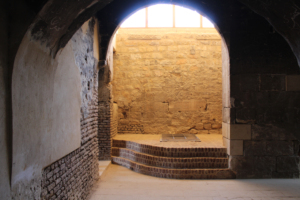
The cistern after full restoration in August 2023. PC: Sally El Sabbahy
Given the amount of structural work executed at the site, material selection was critical. While much of the monument was constructed from Fatimid brickwork, there were also later additions and repairs made during the late Mamluk period that employed different materials and workmanship. Accordingly, specially made bricks that matched the size of the original Fatimid bricks were sourced in Minya and utilized to fill in and repair any losses of brick masonry throughout the Fatimid portions of the monument. Similarly, repairs made to the later additions of the monument relied on the use of larger, saw-cut limestone blocks.

Consolidation and waterproofing of the roof in July 2023. PC: Sally El Sabbahy

An interior shot of the completed vaulted roof, restored after its past collapse. PC: Sally El Sabbahy
The most recent season of work in the summer of 2023 built directly on the improvements made in 2022. A missing section of roof over the cistern was outfitted with a wooden malqaf or wind scoop, facing north, to provide natural lighting and ventilation to the interior. New limestone paving was also laid throughout the interior of the Shrine, save for the areas of original flooring which were left intact and visible. The collapsed vault was also fully restored with a limestone groin vault, without the use of a supporting timber frame – a major engineering feat of the 2023 season! The roof was then outfitted with waterproofed sheeting and sealed with limestone paving set over sand insulation. For security reasons, a protective enclosure wall was also constructed to the south of the Shrine, eliminating any unwarranted access to the roof and dome of the monument.
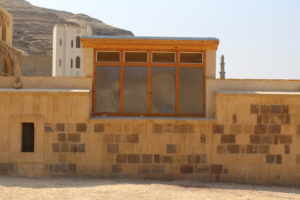
The malqaf or wind scoop, following its complete installation in August 2023. PC: Sally El Sabbahy
ARCE will return to the Shrine of Ikhwat Yusuf in 2024 for a final season of work that will see the fine conservation of the monument’s mihrab and its plastered surfaces, and the installation of visitor information at the site. The ceramics and other small finds made throughout the duration of the project will also be selectively displayed inside the Shrine following the completion of their study and recording. While the Shrine is presently closed to the public, curious visitors are welcome to visit and view it from the outside.

The northern façade of the Shrine of Ikhwat Yussuf, following the completion of the 2023 season. PC: Sally El Sabbahy